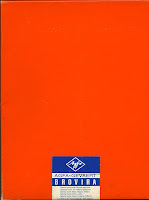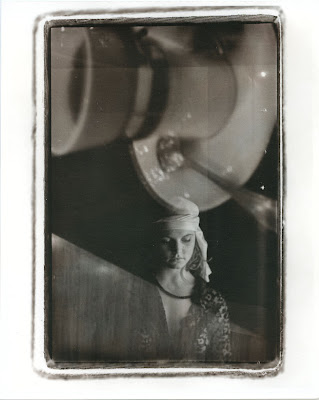That Unkind Cut
Thursday, August 19, 2010

Back in my 20s sometime in the early 60s happiness was retiring to a darkroom with a few negatives, Stan Getz Focus on the reel to reel tape recorder, and an unopened box of 100 sheets of Agfa b+w photographic paper.
To get the drift of this blog it is important to understand that in photography there has always been an incompatibility of dimension. This incompatibility might have begun as competition between the French and the English. The French had their new-fangled metric system while the English relied on their imperial one. By the 1930s photographs, thanks to the influence of the British Empire were measured in inches. Large format cameras had plates or film in 4x5, 5x7, 8x10 and 11x14 inch sizes.

Incompatibility between the inch and the millimeter was unknowingly ushered in the 1890s when the original use of 35mm film (film with sprockets that is 35mm wide) was pioneered by Edison for his Kinetoscope a primitive moving picture system.
The 35mm film format was introduced into still photography as early as 1913 (the Tourist Multiple) but first became popular with Oskar Barnack's Leica in 1925.

A 35m negative is 35mm wide but each individual picture is 24mm wide by about 36mm long. For generations photographers have photographed their loved ones from head to foot (with little room at the top or at the bottom) to then find themselves dismayed when their 8x10 or 5x7s cropped them so parts of their heads were missing or the feet were cut off. A little investigation into the problem will reveal that an 8x10 inch photograph is a fatter rectangle than that of a 24 by 35mm one. One would define this as an incompatibility of aspect ratios. Because frames have been standardized for so long, unless you went to a custom framer you were stuck with odd sizes. This became even more pronounced when labs in the 60s came up with the concept of the full frame cropping of 35mm negatives. This meant that your 35mm negative (or slide) would be printed on to 8x10 paper with extra wide borders on the long side of the picture.

As photography of the 4x5 and 8x10 view camera (large cameras, usually with bellows) kind began to disappear in the latter part of the 20th century, the odd sized photographs gained in popularity even though to this day a box of 8x10 paper (be it photographic or ink-jet) is still a standard format.
Because by the 50s, 35mm film had surpassed the larger 120 film which was introduced by Kodak in 1901 for their Brownie No 2, this larger film has all but disappeared even though it is still made (I use it ). The film is called 120 not because of its size (it comes in lengths of 30 inches or twice that in its 220 format and is 2½ inches wide) but because of a Kodak designation number. Thus 35mm film is called 135 by Kodak.

I still use my Mamiya RB-67 which I load with 120 film. The camera provides me with 10 exposures that are 2¼ by 2¾ inches or 6x7cm). It is called the ideal size or ideal format as the aspect ratio is closer to 8x10 and little is cropped of the negative when exposed to 8x10 paper. I have never felt much liking for the Hasselblad’s (it also uses 120 film) 6x6cm square format because as a magazine photographer I find the rectangle a much more useful shape to work with.
Back to that first paragraph of being in a darkroom with a good negative and some music I would only add that the darkroom in question was not mine. I had yet to have one. I used one at the University of the Americas in Mexico City and there was another one that was leant to me by a wealthy female photographer. She owned a Beseler 4x5 enlarger that had a motor for raising and lowering the enlarger head. It was a dream. In those days, when I knew even less about photography that I think I know now, I had no idea of in camera cropping. I would shoot haphazardly and then crop in the darkroom using an easel (it holds the photographic paper flat) that had adjustable sides. Pictures that I had shot as verticals emerged, after a few hours as squares or horizontals. It was fun but frustrating. It was fun but expensive as I used lots of paper. After a while I learned at least one practical trick. I would shoot portraits giving lots of space over my subject’s head which allowed for the difference in aspect ratios between my Pentaxes 35mm format and standard 5x7, 8x10, 11x14 and increasingly ( I liked to print big) 16x20 photographic paper.
But by the early 70s I began to pride on the fact that I would crop with the camera. This meant that before I pressed on the shutter I made sure that everything in my picture was exactly what I wanted. I would then compensate slightly for the aspect ratio incompatibility.
It was only in the late 70s in Vancouver that I began to print my 35mm negatives full-frame and “float” them on 8x10 paper. It was about then that photographers devised the filed edge negative carrier. With a metal file these photographers (including this one) filed the metal enlarger negative carrier so that the carrier would show the whole negative and a bit more. When we photographers printed with this method we did it for three reasons:

1. We liked to brag that we cropped with our camera.
2. It looked nice.
3. Since no two enlarger negative carriers could be filed in exactly the same way the look became most personal. It meant that the photographer had printed the negative.
This look faded away as film began to disappear and digital photography bypassed enlargers. Photoshop and other photo programs now provide photographers with a nostalgia for the past (or for photographers who ignore the original reason for it and simply like the look) with a filed-edge look that can be attached to the digitally taken picture. These would be the equivalent of attaching fake shoe strings to Velcro closed shoes.
Cropping or knowing how to shoot when one knows the picture is to be cropped is a most necessary skill in magazine photography. For covers (an interesting exception can be seen here) the photographer has to allow room for the name of the magazine, side info and of late room (or an uniform dark or light space) for the price scan. Not doing this sort of thing could be lethal back in the pre-days to that most useful Photoshop device called the cloning tool. With this tool stuff can be added, even lower body parts or the top of a head!
For most of my years as a magazine photographer my pictures were routinely uncropped by art directors. The reason is that I always shot my pictures as horizontals and as verticals. You never knew when the art director would have a change of heart and the assigned two-page spread became a vertical page bleed (the picture went to all four edges of the page with no border). This photographer rarely made the mistake of not allowing or considering where the gutter (the division between pages) would fall on a person’s face in a two-page spread.

Alas all this knowledge is now for naught since I now rarely shoot for magazines.
But I find increasingly (to my sorrow) that I am beginning to crop after I shoot precisely because I crop in camera. This pertains exclusively to shooting nudes. I find that I have thousands of beautifully shot and in-camera cropped pictures that show bits and pieces that cannot appear in this blog. I learned my lesson about three years ago when the UBC Botanical Garden web site linked to my blog because of my plant scans. As soon as I started putting in racy pictures the link was intentionally broken by the learned folks at UBC.
I am told that I cannot publish pictures of my granddaughters hand in hand with nudes. This means that I must self-censor. My self-censorship breaks down sometimes as it did last week. One of my iPhone nudes showed a generous amount of glorious nipple. My subject pointed this out. I removed the picture immediately.
Of late, when I shoot nudes, I consciously snap a few that I know will past muster with that doppelganger censor and that is the case with the iPhone pictures featuring the black cat that covers what cannot show.

Included in today’s blog are pictures I took of Nina Gouveia (alas this excellent subject of mine is now in Spain) that I have cropped with my scanner so that you the viewer here will not be offended. If you have a good imagination you can imagine what is missing. Two of the pictures (in b+w) show the filed edge look of the 6x7 cm format (Nina with friend Bif, above, left) and the 35mm format (Quilla in an accidental double- exposure with a tea cup, right). The third b+w is a box camera scan of two negatives in which the film is indeed 120 but the format is not 6x7 but 6x9. Again it is Nina and Bif playing the inmates of an imagined house of prostitution in Mexico sometime in the 40s.
Today my journey into the darkroom is efficient and brief. I never crop and I don't miss that motorized Beseler 45. My Beseler 23C is just fine. I play no distracting music.






